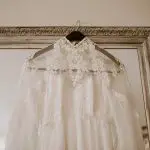Have you ever seen a business card or invitation with a shiny metallic finish? That’s foil printing!
Foil printing is a popular technique used to add a touch of luxury and sophistication to various printed materials. Whether you’re a business owner looking to elevate your branding or a bride-to-be seeking elegant wedding invitations, foil printing can add a special touch to your project.
But what exactly is foil printing? Foil printing, also known as foil stamping or hot stamping, is a printing process that involves using a heated die to press a thin layer of metallic or colored foil onto a paper or cardstock surface. The result is a shiny and eye-catching design that stands out from traditional printing methods.
In this article, we’ll explore the ins and outs of foil printing, including how it works, different techniques, and applications. So, let’s get started!
Table of Contents
Understanding Foil Printing
You’ll want to understand how foil printing works if you’re looking to add an elegant touch to your printed materials. Foil printing is a technique that uses metallic or pigmented foil to create a shiny, reflective design on paper or other materials. This process involves transferring the foil onto the surface using heat and pressure.
Foil printing is a popular choice for wedding invitations, business cards, and other high-end print materials. It adds a luxurious look and feel to any design. The foil can come in various colors, including gold, silver, rose gold, copper, and holographic.
To create a foil print, a special die is made with the design you want to print. Then, the die is heated and pressed onto the foil, which transfers the metallic layer onto the paper or other material. The result is a stunning, eye-catching design that’s sure to impress.
Foil printing is a great way to make your printed materials stand out and leave a lasting impression on your audience.
How Does Foil Printing Work?
When using foil printing, heat and pressure are applied to transfer a metallic sheen onto the desired surface. The process involves printing a design onto a special type of paper that’s coated with heat-activated adhesive. Then, a piece of foil is placed on top of the design. The paper and foil are run through a machine that applies heat and pressure to transfer the foil onto the paper.
The heat and pressure cause the adhesive to melt and bond the foil to the paper, leaving behind a shiny metallic design. Foil can come in a variety of colors, including gold, silver, and copper. It can be used to add a touch of luxury and elegance to any design.
Foil printing is often used for printing on invitations, business cards, packaging, and other promotional materials. It can also be used for creating artwork and adding embellishments to scrapbooks and other craft projects. With its ability to add a unique and eye-catching element to any design, foil printing has become a popular choice for many businesses and individuals looking to make a statement.
Different Foil Printing Techniques
There are various techniques that can be employed to create unique and captivating metallic designs on paper and other surfaces.
One of the most popular techniques is called hot foil stamping. This involves using heat and pressure to transfer a thin layer of metallic foil onto the surface of the paper or other material. The foil is pressed onto the material using a special die, which is heated up to a very high temperature. The heat and pressure cause the foil to stick to the material, creating a beautiful and durable metallic design.
Another technique that is commonly used is cold foil printing. This involves using a special adhesive to transfer a layer of metallic foil onto the surface of the material. The adhesive is applied to the material in the shape of the design, and the foil is then pressed onto the adhesive using a special roller. The foil adheres to the adhesive, creating a beautiful and durable metallic design.
There is also a technique called digital foil printing, which uses a special printer and foil to create metallic designs on paper and other materials. This technique is similar to traditional printing, but instead of using ink, it uses a special foil that is transferred onto the material using heat and pressure. Digital foil printing is a great option for creating metallic designs that are complex or require a high level of detail, as the printer can create very fine lines and intricate designs.
Applications of Foil Printing
Foil printing can add a touch of elegance and sophistication to invitations, business cards, and other paper products. The shiny metallic finish that foil printing provides can make any design stand out. This is why it’s a popular choice for weddings, corporate events, and other special occasions.
Apart from adding a touch of luxury, foil printing can also be used to highlight important information. For example, if you’re designing a business card for a CEO, you can use foil printing to highlight their name and position. This will make it easier for people to remember who they’re talking to and what their role is in the company.
Foil printing can also be used to create unique and eye-catching designs. You can experiment with different colors, textures, and patterns to create a design that’s truly one-of-a-kind. Whether you’re designing a wedding invitation or a product brochure, foil printing can help you create a memorable and impactful design that will capture people’s attention.
Choosing the Right Foil for Your Project
Selecting the appropriate type of metal coating is crucial in achieving the desired effect for your project. Here are some factors to consider when choosing foil for your printing project:
-
Color: Different foils come in different colors, so you need to choose the one that matches your design. If you’re looking for something shiny, go for gold or silver; if you want a pop of color, there are a variety of options available.
-
Texture: Foil can come in different textures, such as matte, glossy, or holographic. Think about the look and feel you want to achieve and choose the appropriate texture accordingly.
-
Adhesion: The foil’s ability to stick to the surface is another important factor to consider. Some foils require heat to adhere properly, while others can be applied with pressure alone. Make sure you choose a foil that’s compatible with the printing method you’re using.
By taking these factors into consideration, you can choose the right foil for your project and achieve the desired effect.
Don’t be afraid to experiment with different types of foil to create something truly unique!
Working with a Foil Printing Service
When you work with a professional service for your foil printing needs, you can benefit from their expertise and experience in creating high-quality, visually stunning designs. A foil printing service can provide you with a range of options to choose from, including different types of foils, colors, and finishes. They can also help you with the design process, ensuring that your final product is exactly what you envision.
One of the biggest advantages of working with a foil printing service is their ability to provide you with a high level of customization. They can create unique designs based on your specific needs and preferences, and can help you choose the right foil and finish to achieve the desired effect. Additionally, they can offer guidance on the best printing techniques to use, ensuring that your final product is of the highest quality.
To ensure that you get the most out of your foil printing service, it’s important to choose a reputable provider with a proven track record of success. Look for a company that specializes in foil printing and has a portfolio of high-quality work that showcases their expertise. You should also consider their level of customer service, as a good service provider will be responsive to your needs and provide you with regular updates throughout the printing process. By working with a professional foil printing service, you can create a unique and visually stunning product that is sure to stand out from the crowd.
| Types of Foils | Colors | Finishes |
|---|---|---|
| Metallic | Gold, silver, copper, rose gold, etc. | Gloss, matte, holographic, brushed, etc. |
| Pigment | Red, blue, green, etc. | Satin, pearl, velvet, etc. |
| Holographic | Rainbow, silver, gold, etc. | Glitter, iridescent, prism, etc. |
- Where Does Hemp Come From? - April 22, 2024
- Why Do People Eat Hemp? - April 22, 2024
- Is Hemp Safe for Humans? - April 22, 2024




